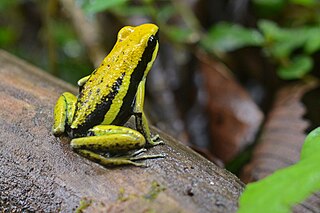
The pleasing poison frog is a species of frog in the family Dendrobatidae endemic to Peru. The specific name bassleri honors Harvey Bassler, an American geologist and paleontologist.

Ameerega bilinguis, the Ecuador poison frog, is a species of frogs in the family Dendrobatidae found in Colombia, Ecuador, and possibly Peru.
Ameerega boliviana, formerly Epipedobates bolivianus, is a species of frog in the family Dendrobatidae endemic to Bolivia. Its natural habitats are subtropical or tropical moist montane forests, rivers, freshwater marshes, intermittent freshwater marshes, pastureland, rural gardens, and heavily degraded former forests.
Ameerega braccata, formerly Epipedobates braccatus, is a species of frog in the family Dendrobatidae. It is endemic to the Central-West Region of Brazil and is known from southern Mato Grosso, Mato Grosso do Sul, and southwestern Goiás states; however, it is likely that its true range extends into adjacent Bolivia and Paraguay.
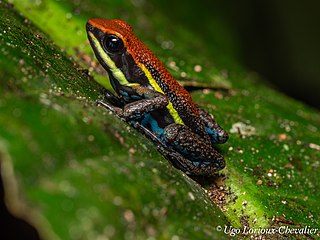
The Cainarachi poison frog is a species of frogs in the family Dendrobatidae. It is endemic to Amazonian Peru and found in the lowlands adjacent to the northern end of the Eastern Andes. It was named after the Rio Cainarache Valley, where it was first discovered.

Lutz's poison frog is a species of frog in the family Dendrobatidae found in Bolivia and Brazil. Its natural habitats are subtropical or tropical moist lowland forests, subtropical or tropical moist montane forests, moist savanna, subtropical or tropical moist shrubland, rivers, intermittent freshwater marshes, and rocky areas. Reproduction occurs in rocky pools and streams. Eggs are laid under a rock and the male transports tadpoles to wet trenches or small rocky pools. It is threatened by habitat loss.
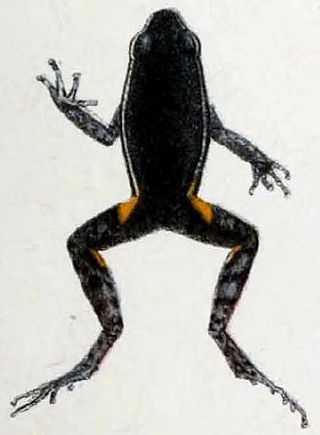
Ameerega hahneli is a species of frog in the family Dendrobatidae. It is found in the Amazonian lowlands of Brazil, Bolivia, Peru, Ecuador, Colombia, Venezuela, Guyana, French Guiana, and Suriname. It is named after Paul Hahnel, the collector of the type series.
Ameerega ingeri, sometimes known as the Niceforo's poison frog, Brother Niceforo's poison frog, or Inger's poison frog, is a species of frog in the family Dendrobatidae. It is endemic to the Colombian Amazon. It is known with certainty only from its type locality in the Caquetá Department. Records from the Putumayo Department ascribed to this species likely refer to Ameerega bilinguis, although other sources continue to include Putumayo in the range of Ameerega ingeri.

The Manú poison frog is a frog species in the family Dendrobatidae found in southern Peru and Brazil. It can be found in the drainages of the Manú, Urubamba, Upper Purus and Ucayali Rivers. It can also be found in Serra do Divisor National Park and Alto Juruá Extractive Reserve.
The confusing poison frog is a species of frog in the family Dendrobatidae endemic to Panama. It is only known from its type locality, "Chiriqui".

The Peru poison frog, also known as Peruvian poison frog, Peruvian poison-arrow frog and emerald poison frog, is a species of frog in the family Dendrobatidae. It is found in eastern Peru and western Brazil. Its natural habitats are primary premontane and subtropical or tropical moist lowland forests, rivers, freshwater marshes, and intermittent freshwater marshes.
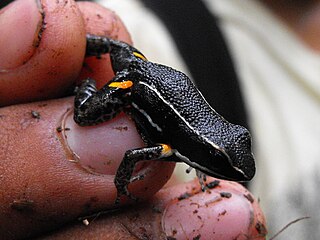
The spot-legged poison frog is a species of dendrobatid frog found in Bolivia, Brazil, Peru, and Venezuela. Its habitat includes tropical and subtropical moist broadleaf forests, especially freshwater swamp forests.
The Oxapampa poison frog is a species of frog in the family Dendrobatidae endemic to Peru near Oxapampa, in the Pasco Region. Its natural habitat is montane tropical rainforest. It is a very rare species threatened by habitat loss.
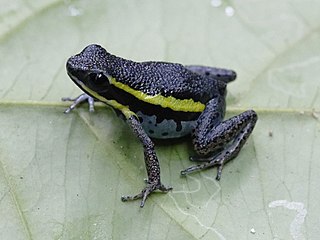
Ameerega pongoensis, formerly Epipedobates pongoensis, is a species of frog in the family Dendrobatidae that is endemic to the San Martín and Loreto Regions of Peru. Its natural habitats are subtropical or tropical moist lowland forests, subtropical or tropical moist montane forests, rivers, freshwater marshes, and intermittent freshwater marshes. It is threatened by encroaching agriculture and is illegally harvested for the pet trade.

Ameerega pulchripecta, formerly Epipedobates pulchripecta, is a species of frog in the family Dendrobatidae endemic to Brazil. Its natural habitats are subtropical or tropical moist lowland forests and intermittent freshwater marshes. It is threatened by habitat loss.
Silverstone's poison frog is a species of frog in the family Dendrobatidae endemic to Peru. Its natural habitats are subtropical or tropical moist lowland forests and rivers.

Ameerega trivittata, formerly Epipedobates trivittatus, is a species of frog in the family Dendrobatidae commonly known as the three-striped poison frog. It is found in Bolivia, Brazil, Colombia, Guyana, Peru, Suriname, Venezuela, possibly Ecuador, and possibly French Guiana.
Ameerega ignipedis is a species of poison frog found in central Peru. It is similar to Ameerega petersi, but differs from the latter in call and size, by having allopatric distributions, and by not being close relatives. It is also similar in appearance to A. pongoensis, although the latter doesn't possess flash marks above its groin and has a different call. It is also related to A. bassleri, a much larger species which usually possesses a yellow or orange dorsum.

Ameerega shihuemoy, the Amarakaeri poison frog, is a species of dart frog endemic to a small region in southeastern Peru in the Manú District where it lives in the transition zone between montane rainforest and the lowland rainforest. The frog is a member of the Ameerega picta group. It was discovered at the Manú Learning Centre where it is known to occur in pieces of selectively logged forest. This species is threatened by habitat loss due to agriculture, gold mining, oil extraction, road construction, and logging. Currently the frog is only known from nine locations globally; three sites in the Manú Biosphere Reserve, and six in Amarakaeri Communal Reserve. Initially it was considered for a status of vulnerable or near-threatened, but due to its low number of known localities it has been considered endangered.

Ameerega boehmei is a species of frog in the family Dendrobatidae. It is endemic to the Chiquitania region in the Santa Cruz Department, Bolivia, where it is known from two isolated sandstone massifs, Serranía de Santiago and Serranía de Chochis. It is similar to Ameerega flavopicta and has been confused with that species. The specific name boehmei honors Wolfgang Böhme, for "his support of the scientific careers of all authors from early days on". Common name Boehmei's poison arrow frog has been proposed for this species.














